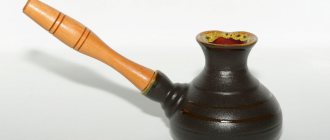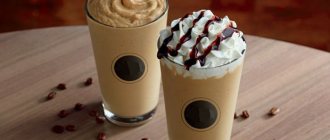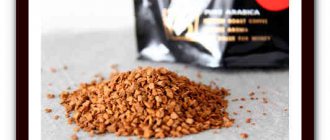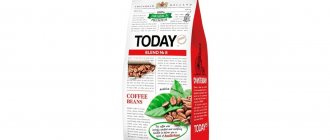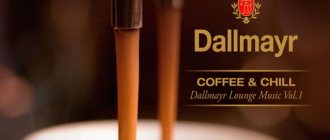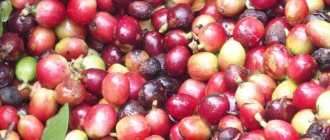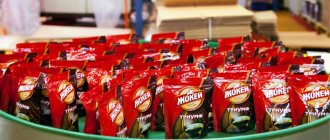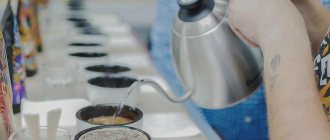History of freeze-dried coffee
Even in a regular freezer, food tends to dry out a little over time. The lower the pressure and temperature, the faster the drying process occurs, and in a vacuum, water evaporates almost instantly.
The technology of freeze drying (freezing, sublimation), developed in 1906 by the French biophysicist Jacques-Arsene d'Arsonval, is based on this natural property of water. The method was subsequently used to make vaccines. During World War II, the American scientific organization National Research Corporation (NRC) used freeze-drying technology to produce antibiotics and transport blood serum for the army.
After the war, NRC scientists turned to civilian projects. It turned out that when dry foods are frozen, they retain much more nutrients than when cooked. Experiments with freeze-drying coffee lasted more than 10 years, and only in 1965 the Nestle company released the world's first instant freeze-dried coffee, Nescafe Gold.
Consumers liked the drink so much that over the next 15 years, most well-known companies also began to produce instant coffee using the sublimation method. By the 1980s, up to 40% of instant coffee was produced using this method. The freezing technology is called freez dried.
Don Valencia, head of research and development at Starbooks, has spent over 20 years creating the perfect freeze-dried coffee, indistinguishable from the real thing. The scientist experimented not only with the temperature and time of freezing, but also selected varieties of coffee beans that were most suitable for making freeze-dried coffee, and used various roasting methods.
At the beginning of the 21st century, Mr. Valencia managed to obtain freeze-dried coffee called “Stardust.” It is now added to all Pepsi canned coffee drinks. After the scientist's death in 2007, Stardust was renamed in honor of its inventor, and is now called Via.
What is instant coffee
Instant coffee is common all over the world. In some countries it is more, in others it is less. It depends on the culture of the local population. In Russia, it is considered very popular due to the fact that you do not need to spend a lot of time brewing the aromatic drink.
The manufacturing process is much cheaper than its sublimated counterpart. The concentrate is simply sprayed into a stream of hot air, resulting in the formation of a fine powder.
Differences between freeze-dried coffee and powdered and granulated coffee
You often read that instant coffee is made from low-quality beans, which are sometimes even difficult to sell in their raw form. However, freeze-dried coffee, unlike granulated and powdered coffee, retains some of the aroma and taste of the original raw material. Therefore, to produce such coffee, higher quality beans are needed: ripened, calibrated, cleared of pulp in compliance with technology, and not emitting an unpleasant odor.
Benefits and harms
The real benefits are found only in natural fruits. But freeze drying makes it possible to preserve at least a small fraction of the unique composition of the grains. Some vitamins and microelements do not have time to evaporate on the factory line. The sublimate contains a small dose of vitamins PP and B2, iron, phosphorus, calcium, sodium.
This composition has a beneficial effect on brain function, digestive organs, and the strength of bone tissue. The caffeine content is optimal for raising tone and stimulating brain activity. A cup of freeze-dried coffee will instantly provide energy and improve your mood.
How to make freeze-dried coffee
Making freeze-dried coffee begins with roasting the beans. Every company has its own secret. For example, the producers of Colombian coffee Buencafé are proud that they use only high-quality Arabica beans, and roast the beans very slowly, which eliminates the appearance of a burnt smell and taste in the finished product.
After roasting, the beans are ground, aromatic substances are extracted, and brewed to obtain coffee concentrate. But if for powdered and granulated coffee the concentrate is sprayed with a stream of hot air, then when producing freeze-dried coffee the concentrate is cooled to –6 °C, which makes it more viscous.
The semi-frozen liquid is placed on a conveyor belt and deep frozen to a temperature of –40 to –50 °C. The faster the freezing, the lighter the freeze-dried coffee granules will be. The ice is then crushed and sifted. Large pieces of ice are sent to a vacuum cryochamber, small pieces are sent for re-freezing. In a vacuum cryochamber, water evaporates. The size of the granules depends on the size of the ice floes. If you dry too small pieces of ice, you will get a powder, which is unacceptable according to the standard.
Coffee concentrate contains aromatic substances (although much less of them than in natural beans). When dried hot, they completely evaporate, but when frozen, they are preserved. That’s why manufacturers indicate on the packaging: “natural freeze-dried coffee.” However, the granules are usually additionally flavored.
Freeze-dried coffee granules are harder than those obtained by hot drying granules. Frozen coffee dissolves slightly more slowly in water.
Composition and calorie content
The composition of freeze-dried coffee includes oils obtained from natural coffee beans. The main ingredients are chemical additives, stabilizers and preservatives, since after processing no minerals and vitamins remain in the coffee product.
The amount of caffeine depends on its content in natural beans and ranges from 30 to 100 mg per serving. However, due to the uneven distribution of caffeine throughout the bulk of the product during the preparation process, it is almost impossible to calculate the exact content of the alkaloid in the finished drink. One spoon of freeze-dried coffee may contain more of the tonic than another.
The calorie content of the substance is in the range of 80-250 kcal per 100 g of dry product.
Nowadays, on store shelves you can often find a drink marked “decaffeinated” on the packaging. This is the most harmful type of instant coffee, containing dangerous acids and carcinogens that increase the risk of malignant tumors.
How to choose freeze-dried coffee
Freeze-dried coffee is most often sold in transparent cans; you can choose a quality product based on appearance and label:
- there should be no powder at the bottom of the jar;
- Responsible producers indicate on the label what varieties the freeze-dried coffee is made from: 100% Arabica or a mixture of Arabica and Robusta. It is believed that 100% Arabica coffee is better, but this is a matter of taste;
- Preference should be given to coffee with natural flavors;
- The color of the granules only indicates the speed of freezing. When quickly frozen, the granules become lighter in color.
Important! If the drink has a burnt cork taste, it means that the roasting technology was violated during the production of freeze-dried coffee, or low-grade, poorly calibrated beans were used. It is better not to buy products from this brand. A musty smell is also unacceptable (appears when the technology for extracting aromatic substances from ground grains is violated).
Conclusions:
- Freeze-dried coffee is made using modern multi-stage technology, thanks to which its composition is almost identical to natural coffee.
- To produce this variety, a technical variety of beans is used - robusta, which contains a higher amount of caffeine and has a tart, bitter aftertaste.
- It is impossible to accurately calculate the amount of caffeine in a serving of freeze-dried coffee, so this drink should not be consumed by children, people with high blood pressure and heart problems.
- If desired, healthy people can, in rare cases, consume freeze-dried coffee without harm to the body. If you drink this coffee occasionally, it will not have any negative effects.
- When choosing instant coffee, it is important to pay attention to the integrity of the packaging and the appearance of the granules themselves. If the can is damaged, and the coffee itself has changed its color or aroma, it means that it was prepared incorrectly, or the manufacturer is trying to sell granulated coffee under the guise of freeze-dried coffee.
Famous brands of freeze-dried coffee
Starbucks Via Instant – there are several types on sale with varying degrees of roasting. The drink tastes like coffee brewed in a French press;
Bushido is a Japanese dark roasted freeze-dried coffee. The aroma is intense, close to natural, the taste is with a pleasant bitterness. Coffee dissolves only in hot water;
Carte Noire is a premium French coffee, there are several types on sale. The granules dissolve in cold water;
Tchibo Exclusive - coffee with a pleasant taste and aroma, belongs to the economy segment;
Nescafe is an inexpensive and very popular coffee. The drink smells nice, but the taste is inexpressive.
What coffee is best, when and for whom?
According to doctors, coffee itself can be a rather harmful product. Especially soluble analogues and in large quantities. But in some cases its use will still be appropriate.
But to understand this issue in more detail, you must first understand who should completely exclude this product from their diet:
- First of all, pregnant and breastfeeding women . Considering the composition of the substitute, it is advisable to opt for a natural drink in small portions.
- The same applies to young children . With frequent use, emotional instability may occur.
- Not recommended for people suffering from cardiovascular problems. Several mugs in a row - and poor health is guaranteed.
- Elderly people need to be careful not only with powdered coffee, but also with natural coffee.
- Sometimes it is better for the driver to drink a mug of strong tea . In some cases, it can fight sleep much better than a cheap powder with almost no caffeine in the composition.
Despite such an impressive list of restrictions, this drink can and should be consumed. But only if we are talking about a high quality product made from natural raw materials:
- Freeze-dried coffee, which is closer to natural coffee than regular powder, contains antioxidants . They help maintain youth and beauty. But cheap mixtures containing harmful substances, on the contrary, can cause deterioration of the skin and hair.
- During processing, nicotinic acid - a source of vitamins and beneficial microelements. It is necessary to improve the functioning of blood vessels, as it helps reduce cholesterol levels.
- A good product that contains a sufficient amount of caffeine will be useful for low blood pressure.
- Necessary for drivers and students, because they often have to stay awake at a time when they really want to sleep. A mug of strong coffee can relieve fatigue, increase efficiency, and improve brain activity.
- A cup of hot aromatic drink itself lifts your mood, helping to get rid of the autumn blues.
How to brew freeze-dried coffee correctly
Ingredients:
- 1–2 tsp. freeze-dried coffee;
- 1–2 tsp. Sahara;
- 100–150 ml of water.
Recipe
Coffee and sugar are poured into a preheated cup, a teaspoon of water is added and thoroughly rubbed to form foam. Then add the rest of the water. It should not be hotter than +90 °C. To heat water, it is boiled until air bubbles appear. You should turn off the kettle and wait 2-3 minutes until the water cools down a little.
The more intensively you beat the coffee with sugar, the more fluffy the foam will be (although whipping freeze-dried coffee is harder than powdered coffee). If you are preparing several servings of the drink, it is convenient to use a mixer for whipping. You can decorate muffins with this foam. Sometimes it is laid on top of natural coffee brewed in a French press or Chemex.
In appearance, freeze-dried coffee cannot be distinguished from coffee brewed by other methods.
Freeze-dried coffee makes delicious milk-coffee cocktails.
Precautions for use
Due to the huge amount of caffeine, the usefulness of the freeze-dried variety of the drink is approximately the same as that of natural coffee. Therefore, its use requires the same caution. The creators of medical research papers limit the daily consumption of both drinks to approximately similar volumes. They should be found with a personal doctor.
- Neglecting reasonable doses is fraught with increased excitability and other adverse reactions from the nervous system.
- When the body processes excess coffee, the liver cells suffer.
- The leaching of potassium from the body caused by the diuretic properties of this drink is unsafe for the functioning of the heart.
- Like natural coffee, the freeze-dried version is not safe to drink on an empty stomach. This can trigger an attack of gastritis.
- Like natural coffee, the freeze-dried version, which increases blood pressure, is harmful for hypertensive patients.
The “horse doses” so beloved by “coffee lovers” are harmful to the body in any case. Be it any type of instant coffee or natural coffee brewed from high-quality freshly ground beans. The usefulness and toxicity of a freeze-dried drink is also determined, first, by the volume of portions in which it is eaten.
The danger of excessive consumption of cheap granulated coffee is that the body becomes clogged with harmful and wasteful substances.
Spray drying and crude preparation of powdered coffee actually deprives it of caffeine, fragrant essential oils and other necessary substances.
Steam treatment of such powder, used to ensure that its small grains stick together into granules, does not improve the taste of the drink.
Therefore, for the production of granulated coffee, they mainly use not the highest quality raw materials. Finished products are often “improved” by adding bitterness in taste and achieving rich aroma using artificial flavors and flavor enhancers. Here, in fact, is the difference between freeze-dried coffee and granulated coffee.
The method and speed of making a cup of instant coffee is similar and does not depend on the production method and price of dry coffee granules. You just need to add boiling water to them. The only benefit of granulated coffee is its relatively low cost. Therefore, for everyone who does not want to save on their health, the conclusion is forced upon itself which coffee is better to buy, freeze-dried or granulated.
Granulated coffee: features, manufacturing technology
Granulated coffee product, like freeze-dried coffee, is obtained from natural coffee beans, only using a different method. We're talking about drying, not freezing. The first production stage is the same as in the first case: after roasting, the grains are crushed and then boiled with steam removed.
But then the technology changes: the semi-finished liquid product is sprayed in an even layer and dried under pressure. The result is a not very dense mass in the form of a powder, which is processed with steam at the final step. Under its influence, the powder is converted into granules - granulated coffee is obtained. The main difference between coffee granules and powder: they do not stick to the spoon.
